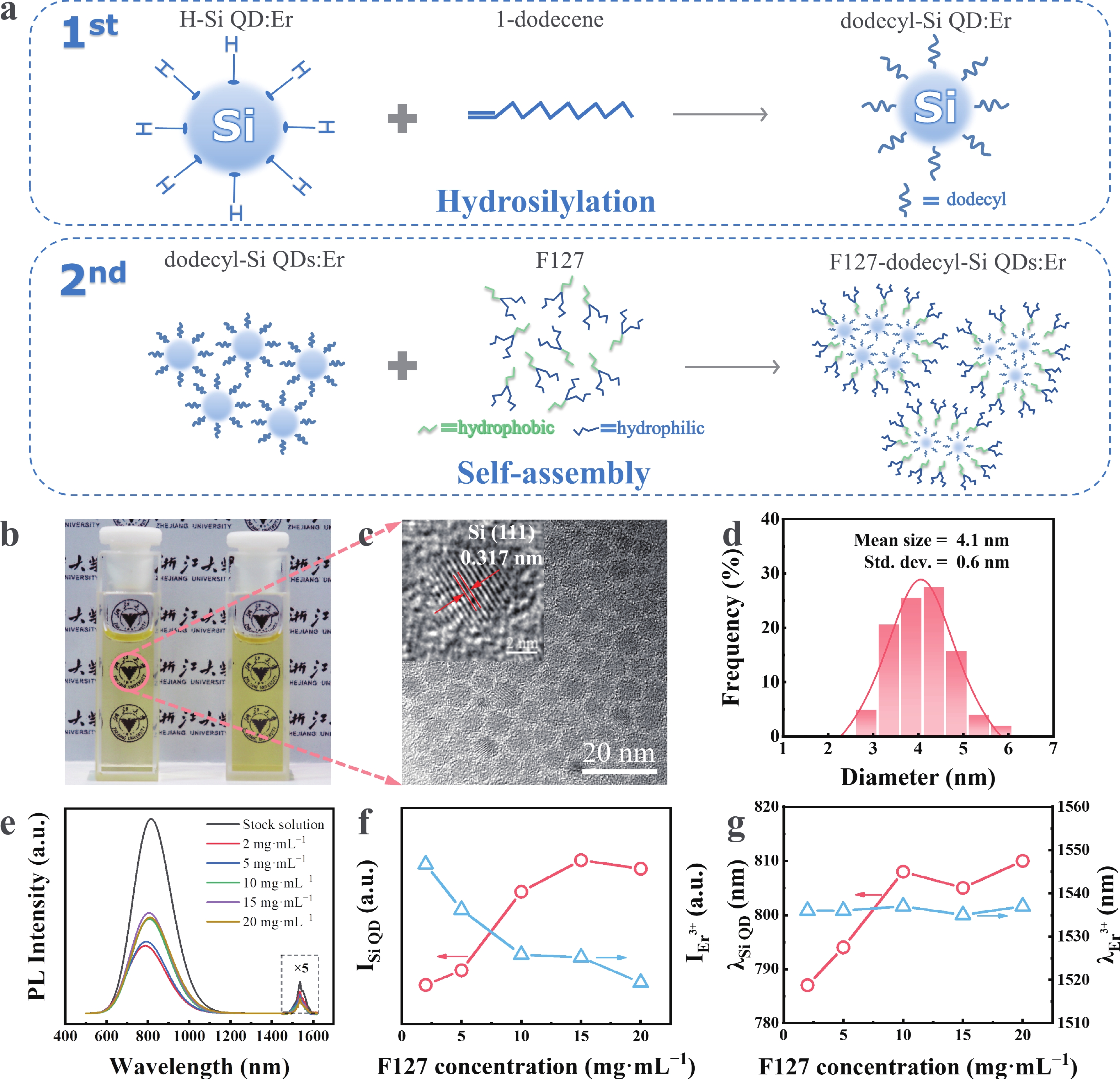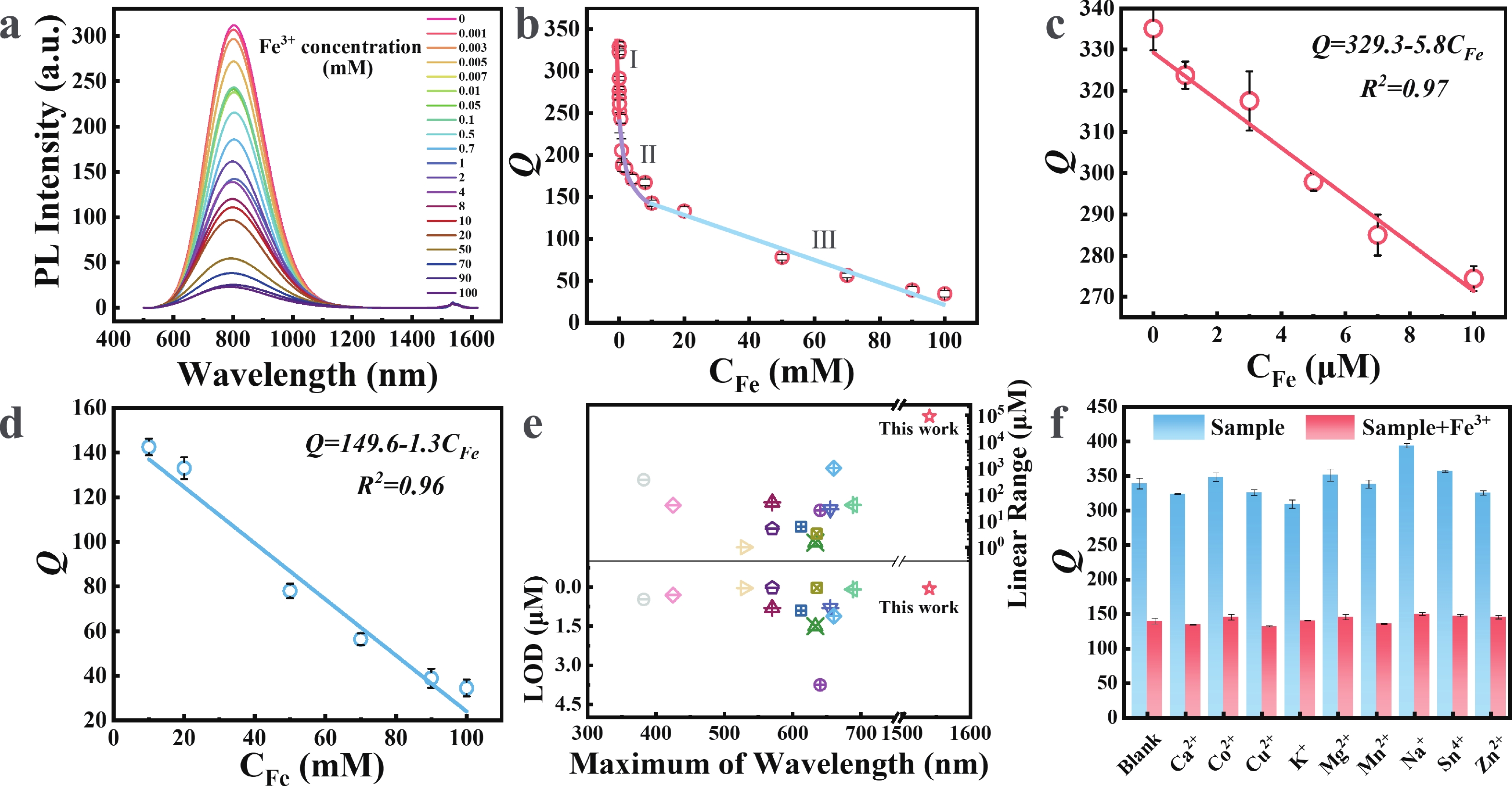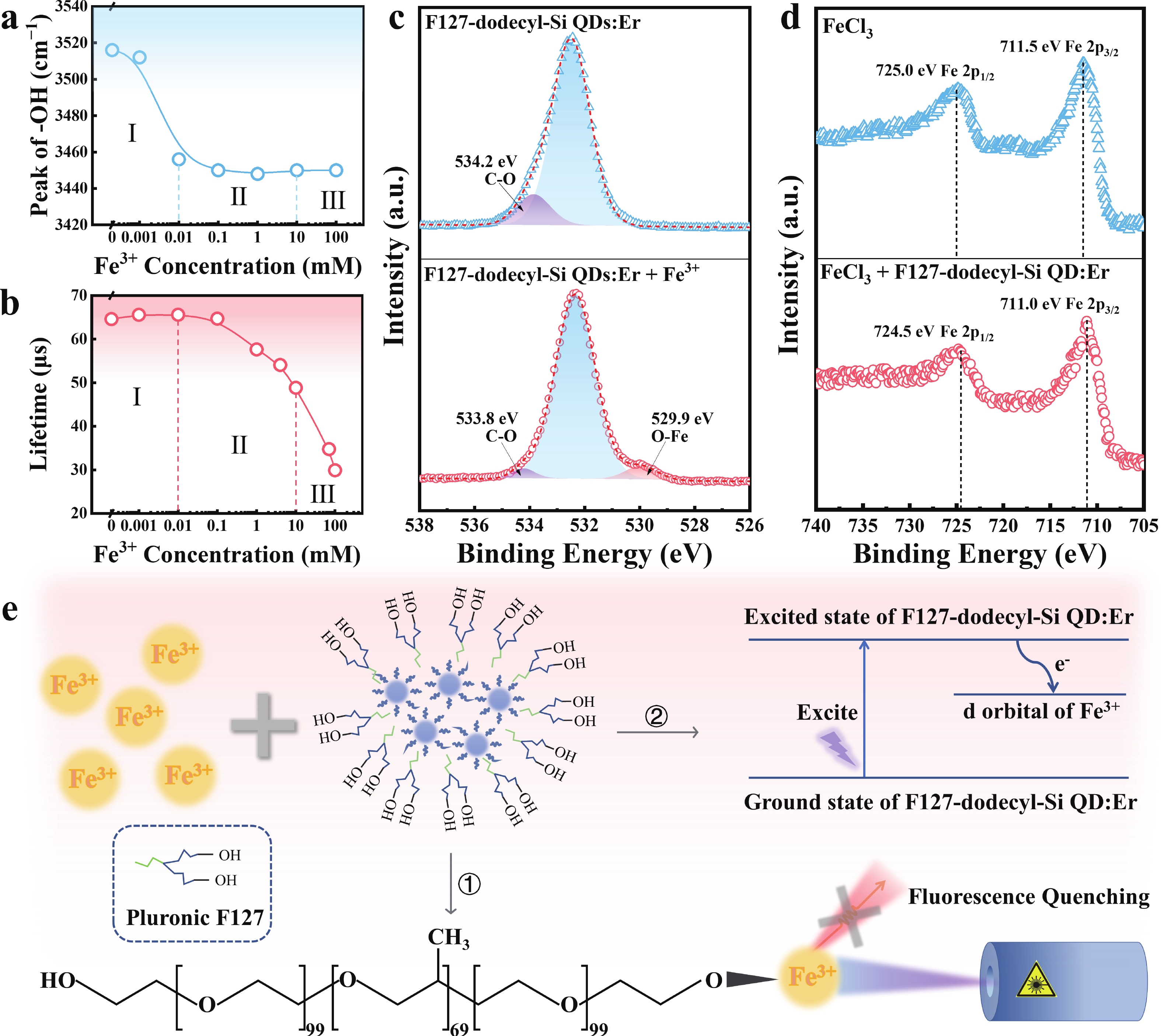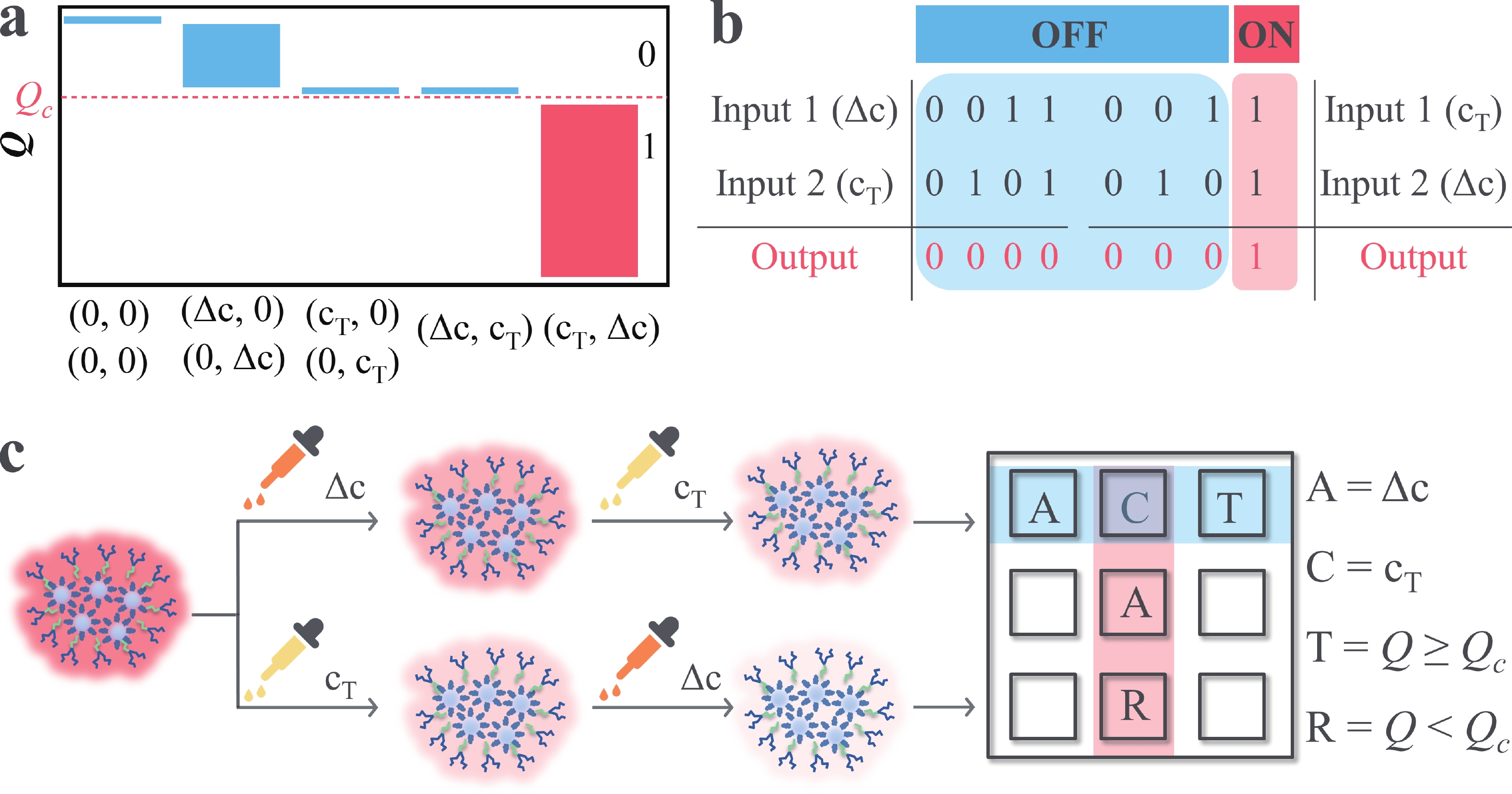| Citation: |
Kun Wang, Wenxuan Lai, Zhenyi Ni, Deren Yang, Xiaodong Pi. A highly sensitive ratiometric near-infrared nanosensor based on erbium-hyperdoped silicon quantum dots for iron(Ⅲ) detection[J]. Journal of Semiconductors, 2024, 45(8): 082401. doi: 10.1088/1674-4926/24020018
****
K Wang, W X Lai, Z Y Ni, D R Yang, and X D Pi, A highly sensitive ratiometric near-infrared nanosensor based on erbium-hyperdoped silicon quantum dots for iron(Ⅲ) detection[J]. J. Semicond., 2024, 45(8), 082401 doi: 10.1088/1674-4926/24020018
|
A highly sensitive ratiometric near-infrared nanosensor based on erbium-hyperdoped silicon quantum dots for iron(Ⅲ) detection
DOI: 10.1088/1674-4926/24020018
More Information
-
Abstract
Ratiometric fluorescent detection of iron(Ⅲ) (Fe3+) offers inherent self-calibration and contactless analytic capabilities. However, realizing a dual-emission near-infrared (NIR) nanosensor with a low limit of detection (LOD) is rather challenging. In this work, we report the synthesis of water-dispersible erbium-hyperdoped silicon quantum dots (Si QDs:Er), which emit NIR light at the wavelengths of 810 and 1540 nm. A dual-emission NIR nanosensor based on water-dispersible Si QDs:Er enables ratiometric Fe3+ detection with a very low LOD (0.06 μM). The effects of pH, recyclability, and the interplay between static and dynamic quenching mechanisms for Fe3+ detection have been systematically studied. In addition, we demonstrate that the nanosensor may be used to construct a sequential logic circuit with memory functions. -
References
[1] Domaille D W, Que E L, Chang C J. Synthetic fluorescent sensors for studying the cell biology of metals. Nat Chem Biol, 2008, 4, 168 doi: 10.1038/nchembio.69[2] Sahoo S K, Sharma D, Ber R K, et al. Iron(iii) selective molecular and supramolecular fluorescent probes. Chem Soc Rev, 2012, 41, 7195 doi: 10.1039/c2cs35152h[3] Qi Y L, Wang H R, Chen L L, et al. Recent advances in small-molecule fluorescent probes for studying ferroptosis. Chem Soc Rev, 2022, 51, 7752 doi: 10.1039/D1CS01167G[4] Wu S, Min H, Shi W, et al. Multicenter metal–organic framework-based ratiometric fluorescent sensors. Adv Mater, 2020, 32, 1805871 doi: 10.1002/adma.201805871[5] Han Y, Yang W, Luo X, et al. Carbon dots based ratiometric fluorescent sensing platform for food safety. Crit Rev Food Sci Nutr, 2022, 62, 244 doi: 10.1080/10408398.2020.1814197[6] Santosa S J, Tanaka S, Yamanaka K. Sequential determination of trace metals in sea water by inductively coupled plasma mass spectrometry after electrothermal vaporization of their dithiocarmabamate complexes in methyl isobutyl ketone. Environ Monit Assess, 1997, 44, 515 doi: 10.1023/A:1005782500773[7] Bobrowski A, Nowak K, Zarębski J. Application of a bismuth film electrode to the voltammetric determination of trace iron using a Fe(III)–TEA–BrO3− catalytic system. Anal Bioanal Chem, 2005, 382, 1691 doi: 10.1007/s00216-005-3313-2[8] Gomes D, Segundo M, Lima J, et al. Spectrophotometric determination of iron and boron in soil extracts using a multi-syringe flow injection system. Talanta, 2005, 66, 703 doi: 10.1016/j.talanta.2004.12.011[9] Ohashi A, Ito H, Kanai C, et al. Cloud point extraction of iron(III) and vanadium(V) using 8-quinolinol derivatives and Triton X-100 and determination of 10−7 mol dm−3 level iron(III) in riverine water reference by a graphite furnace atomic absorption spectroscopy. Talanta, 2005, 65, 525 doi: 10.1016/j.talanta.2004.07.018[10] Chowdhury S, Rooj B, Dutta A, et al. Review on recent advances in metal ions sensing using different fluorescent probes. J Fluoresc, 2018, 28, 999 doi: 10.1007/s10895-018-2263-y[11] Park S H, Kwon N, Lee J H, et al. Synthetic ratiometric fluorescent probes for detection of ions. Chem Soc Rev, 2020, 49, 143 doi: 10.1039/C9CS00243J[12] García de Arquer F P, Talapin D V, Klimov V I, et al. Semiconductor quantum dots: Technological progress and future challenges. Science, 2021, 373, eaaz8541 doi: 10.1126/science.aaz8541[13] Montalti M, Cantelli A, Battistelli G. Nanodiamonds and silicon quantum dots: Ultrastable and biocompatible luminescent nanoprobes for long-term bioimaging. Chem Soc Rev, 2015, 44, 4853 doi: 10.1039/C4CS00486H[14] Qu K, Wang J, Ren J, et al. Carbon dots prepared by hydrothermal treatment of dopamine as an effective fluorescent sensing platform for the label-free detection of iron(III) ions and dopamine. Chem-A Eur J, 2013, 19, 7243 doi: 10.1002/chem.201300042[15] Zhou M, Zhou Z, Gong A, et al. Synthesis of highly photoluminescent carbon dots via citric acid and Tris for iron(III) ions sensors and bioimaging. Talanta, 2015, 143, 107 doi: 10.1016/j.talanta.2015.04.015[16] Wang N, Wang Y, Guo T, et al. Green preparation of carbon dots with papaya as carbon source for effective fluorescent sensing of Iron (III) and Escherichia coli. Biosens Bioelectron, 2016, 85, 68 doi: 10.1016/j.bios.2016.04.089[17] Sun X, Lei Y. Fluorescent carbon dots and their sensing applications. TrAC-Trends Anal Chem, 2017, 89, 163 doi: 10.1016/j.trac.2017.02.001[18] Zhu H, Zhang W, Zhang K, et al. Dual-emission of a fluorescent graphene oxide-quantum dot nanohybrid for sensitive and selective visual sensor applications based on ratiometric fluorescence. Nanotechnology, 2012, 23, 315502 doi: 10.1088/0957-4484/23/31/315502[19] Zhou M, Guo J, Yang C. Ratiometric fluorescence sensor for Fe3+ ions detection based on quantum dot-doped hydrogel optical fiber. Sensors Actuators, B Chem, 2018, 264, 52 doi: 10.1016/j.snb.2018.02.119[20] Guo Z, Huang X, Li Z, et al. Employing CuInS2 quantum dots modified with vancomycin for detecting: Staphylococcus aureus and iron(iii). Anal Methods, 2021, 13, 1517 doi: 10.1039/D0AY02253E[21] Qu Z bei, Zhang M, Zhou T, et al. A single-wavelength-emitting ratiometric probe based on phototriggered fluorescence switching of graphene quantum dots. Chemistry, 2014, 20, 13777 doi: 10.1002/chem.201404160[22] Kim M, Chen C, Yaari Z, et al. Nanosensor-based monitoring of autophagy-associated lysosomal acidification in vivo. Nat Chem Biol, 2023, 19, 1448 doi: 10.1038/s41589-023-01364-9[23] Hazra C, Skripka A, Ribeiro S J L, et al. Erbium single-band nanothermometry in the third biological imaging window: potential and limitations. Adv Opt Mater, 2020, 8, 2001178 doi: 10.1002/adom.202001178[24] Long L, Han Y, Yuan X, et al. A novel ratiometric near-infrared fluorescent probe for monitoring cyanide in food samples. Food Chem, 2020, 331, 127359 doi: 10.1016/j.foodchem.2020.127359[25] Li C, Sun Q, Zhao Q, et al. Highly selective ratiometric fluorescent probes for the detection of Fe3+ and its application in living cells. Spectrochim Acta-Part A Mol Biomol Spectrosc, 2020, 228, 117720 doi: 10.1016/j.saa.2019.117720[26] Zhang J, Jin J, Wan J, et al. Quantum dots-based hydrogels for sensing applications. Chem Eng J, 2021, 408, 127351 doi: 10.1016/j.cej.2020.127351[27] Niu B, Xiao K, Huang X, et al. High-sensitivity detection of iron(III) by dopamine-modified funnel-shaped nanochannels. ACS Appl Mater Interfaces, 2018, 10, 22632 doi: 10.1021/acsami.8b05686[28] Fujii M, Sugimoto H, Imakita K. All-inorganic colloidal silicon nanocrystals-Surface modification by boron and phosphorus co-doping. Nanotechnology, 2016, 27, 262001 doi: 10.1088/0957-4484/27/26/262001[29] Meinardi F, Ehrenberg S, Dhamo L, et al. Highly efficient luminescent solar concentrators based on earth-abundant indirect-bandgap silicon quantum dots. Nat Photonics, 2017, 11, 177 doi: 10.1038/nphoton.2017.5[30] Zhao S, Liu X, Pi X, et al. Light-emitting diodes based on colloidal silicon quantum dots. J Semicond, 2018, 39, 061008 doi: 10.1088/1674-4926/39/6/061008[31] Kortshagen U R, Sankaran R M, Pereira R N, et al. Nonthermal plasma synthesis of nanocrystals: Fundamental principles, materials, and applications. Chem Rev, 2016, 116, 11061 doi: 10.1021/acs.chemrev.6b00039[32] Linehan K, Carolan D, Doyle H. Highly selective optical detection of Fe3+ ions in aqueous solution using label-free silicon nanocrystals. Part Part Syst Charact, 2019, 36, 1900034 doi: 10.1002/ppsc.201900034[33] Zhang X, Li C, Zhao S, et al. S doped silicon quantum dots with high quantum yield as a fluorescent sensor for determination of Fe3+ in water. Opt Mater (Amst), 2020, 110, 110461 doi: 10.1016/j.optmat.2020.110461[34] Peng D, Zhao Z. Highly efficient ferric ion sensing and high resolution latent fingerprint imaging based on fluorescent silicon quantum dots. Spectrochim Acta-Part A Mol Biomol Spectrosc, 2023, 299, 122827 doi: 10.1016/j.saa.2023.122827[35] Larin A O, Dvoretckaia L N, Mozharov A M, et al. Luminescent erbium-doped silicon thin films for advanced anti-counterfeit labels. Adv Mater, 2021, 33, 2005886 doi: 10.1002/adma.202005886[36] Rodríguez J, Veinot J G C. Realization of sensitized erbium luminescence in Si-nanocrystal composites obtained from solution processable sol-gel derived materials. J Mater Chem, 2011, 21, 1713 doi: 10.1039/C0JM02135K[37] Jia M, Fu Z, Liu G, et al. NIR-II/III luminescence ratiometric nanothermometry with phonon-tuned sensitivity. Adv Opt Mater, 2020, 8, 1901173 doi: 10.1002/adom.201901173[38] Kenyon A J. Recent developments in rare-earth doped materials for optoelectronics. Prog Quantum Electron, 2002, 26, 225 doi: 10.1016/S0079-6727(02)00014-9[39] Kenyon A J. Erbium in silicon. Semicond Sci Technol, 2005, 20, R65 doi: 10.1088/0268-1242/20/12/R02[40] Lide D R. CRC Handbook of Chemistry and Physics. CRC Press, 2004[41] Li L, Yu B, You T. Nitrogen and sulfur co-doped carbon dots for highly selective and sensitive detection of Hg (II) ions. Biosens Bioelectron, 2015, 74, 263 doi: 10.1016/j.bios.2015.06.050[42] Wang K, He Q, Yang D, et al. Highly efficient energy transfer from silicon to erbium in erbium-hyperdoped silicon quantum dots. Nanomaterials, 2023, 13, 277 doi: 10.3390/nano13020277[43] Wang K, He Q, Yang D, et al. Erbium-hyperdoped silicon quantum dots: a platform of ratiometric near-infrared fluorescence. Adv Opt Mater, 2022, 10, 2201831 doi: 10.1002/adom.202201831[44] Miritello M, Savio R Lo, Iacona F, et al. Efficient luminescence and energy transfer in erbium silicate thin films. Adv Mater, 2007, 19, 1582 doi: 10.1002/adma.200601692[45] Pi X, Yu T, Yang D. Water-dispersible silicon-quantum-dot-containing micelles self-assembled from an amphiphilic polymer. Part Part Syst Charact, 2014, 31, 751 doi: 10.1002/ppsc.201300346[46] Erogbogbo F, Yong K T, Roy I, et al. In vivo targeted cancer imaging, sentinel lymph node mapping and multi-channel imaging with biocompatible silicon nanocrystals. ACS Nano, 2011, 5, 413 doi: 10.1021/nn1018945[47] Yu J, Song N, Zhang Y K, et al. Green preparation of carbon dots by Jinhua bergamot for sensitive and selective fluorescent detection of Hg2+ and Fe3+. Sensors Actuators B Chem, 2015, 214, 29 doi: 10.1016/j.snb.2015.03.006[48] Lv P, Yao Y, Zhou H, et al. Synthesis of novel nitrogen-doped carbon dots for highly selective detection of iron ion. Nanotechnology, 2017, 28, 165502 doi: 10.1088/1361-6528/aa6320[49] Liu X, Zhao S, Gu W, et al. Light-emitting diodes based on colloidal silicon quantum dots with octyl and phenylpropyl ligands. ACS Appl Mater Interfaces, 2018, 10, 5959 doi: 10.1021/acsami.7b16980[50] Chandra S, Ghosh B, Beaune G, et al. Functional double-shelled silicon nanocrystals for two-photon fluorescence cell imaging: spectral evolution and tuning. Nanoscale, 2016, 9009 doi: 10.1039/C6NR01437B[51] Jung H H, Park K, Han D K. Preparation of TGF-β1-conjugated biodegradable pluronic F127 hydrogel and its application with adipose-derived stem cells. J Control Release, 2010, 147, 84 doi: 10.1016/j.jconrel.2010.06.020[52] Godavarti U D, Nagaraju P, Yelsani V, et al. Synthesis and characterization of ZnS-based quantum dots to trace low concentration of ammonia. J Semicond, 2021, 42, 122901 doi: 10.1088/1674-4926/42/12/122901[53] Sangghaleh F, Sychugov I, Yang Z, et al. Near-unity internal quantum efficiency of luminescent silicon nanocrystals with ligand passivation. ACS Nano, 2015, 9, 7097 doi: 10.1021/acsnano.5b01717[54] Hannah D C, Yang J, Podsiadlo P, et al. On the origin of photoluminescence in silicon nanocrystals: pressure-dependent structural and optical studies. Nano Lett, 2012, 12, 4200 doi: 10.1021/nl301787g[55] Takagahara T, Takeda K. Theory of the quantum confinement effect on excitons in quantum dots of indirect-gap materials. Phys Rev B, 1992, 46, 15578 doi: 10.1103/PhysRevB.46.15578[56] Fujii M, Yoshida M, Kanzawa Y, et al. 1.54 μm photoluminescence of Er3+ doped into SiO2 films containing Si nanocrystals: evidence for energy transfer from Si nanocrystals to Er3+. Appl Phys Lett, 1997, 71, 1198 doi: 10.1063/1.119624[57] Fujii M, Yoshida M, Hayashi S, et al. Photoluminescence from SiO2 films containing Si nanocrystals and Er: Effects of nanocrystalline size on the photoluminescence efficiency of Er3+. J Appl Phys, 1998, 84, 4525 doi: 10.1063/1.368678[58] Zebibula A, Alifu N, Xia L, et al. Ultrastable and biocompatible NIR-II quantum dots for functional bioimaging. Adv Funct Mater, 2018, 28, 1703451 doi: 10.1002/adfm.201703451[59] Liu X, Zhang Y, Yu T, et al. Optimum quantum yield of the light emission from 2 to 10 nm hydrosilylated silicon quantum dots. Part Part Syst Charact, 2016, 33, 44 doi: 10.1002/ppsc.201500148[60] Ye H Q, Li Z, Peng Y, et al. Organo-erbium systems for optical amplification at telecommunications wavelengths. Nat Mater, 2014, 13, 382 doi: 10.1038/nmat3910[61] Winkless L, Tan R H C, Zheng Y, et al. Quenching of Er(III) luminescence by ligand C-H vibrations: Implications for the use of erbium complexes in telecommunications. Appl Phys Lett, 2006, 89, 111115 doi: 10.1063/1.2345909[62] Wojdak M, Klik M, Forcales M, et al. Sensitization of Er luminescence by Si nanoclusters. Phys Rev B, 2004, 69, 1 doi: 10.1103/PhysRevB.69.233315[63] Lai T, Zheng E, Chen L, et al. Hybrid carbon source for producing nitrogen-doped polymer nanodots: One-pot hydrothermal synthesis, fluorescence enhancement and highly selective detection of Fe(iii). Nanoscale, 2013, 5, 8015 doi: 10.1039/c3nr02014b[64] Chan C C, Lam H, Lee Y C, et al. Analytical method validation and instrument performance verification. Hoboken: John Wiley & Sons, 2004[65] Xiang Y, Lu Y. Using personal glucose meters and functional DNA sensors to quantify a variety of analytical targets. Nat Chem, 2011, 3, 697 doi: 10.1038/nchem.1092[66] Mirlohi S, Dietrich A M, Duncan S E. Age-associated variation in sensory perception of iron in drinking water and the potential for overexposure in the human population. Environ Sci Technol, 2011, 45, 6575 doi: 10.1021/es200633p[67] Wang Y, Lao S, Ding W, et al. A novel ratiometric fluorescent probe for detection of iron ions and zinc ions based on dual-emission carbon dots. Sensors Actuators, B Chem, 2019, 284, 186 doi: 10.1016/j.snb.2018.12.139[68] Chen Z, Xu X, Meng D, et al. Dual-emitting N/S-doped carbon dots-based ratiometric fluorescent and light scattering sensor for high precision detection of Fe(III) ions. J Fluoresc, 2020, 30, 1007 doi: 10.1007/s10895-020-02571-6[69] Pang S, Liu S. Dual-emission carbon dots for ratiometric detection of Fe3+ ions and acid phosphatase. Anal Chim Acta, 2020, 1105, 155 doi: 10.1016/j.aca.2020.01.033[70] Wang B, Zhou X Q, Lin J M, et al. Concentration-modulated dual-excitation fluorescence of carbon dots used for ratiometric sensing of Fe3+. Microchem J, 2021, 164, 106028 doi: 10.1016/j.microc.2021.106028[71] Liu Q, Zhao F, Shi B, et al. Mussel-inspired polydopamine-encapsulated carbon dots with dual emission for detection of 4-nitrophenol and Fe3+. Luminescence, 2021, 36, 431 doi: 10.1002/bio.3961[72] Guo X, Pan Q, Song X, et al. Embedding carbon dots in Eu3+-doped metal-organic framework for label-free ratiometric fluorescence detection of Fe3+ ions. J Am Ceram Soc, 2021, 104, 886 doi: 10.1111/jace.17477[73] Nandi N, Choudhury K, Sarkar P, et al. Ratiometric multimode detection of pH and Fe3+ by dual-emissive heteroatom-doped carbon dots for living cell applications. ACS Appl Nano Mater, 2022, 5, 17315 doi: 10.1021/acsanm.2c04531[74] Liu Y, Hu X, Liang F, et al. A FRET sensor based on quantum dots–porphyrin assembly for Fe(III) detection with ultra-sensitivity and accuracy. Anal Bioanal Chem, 2022, 414, 7741 doi: 10.1007/s00216-022-04305-y[75] Kuang Y, Wang X, Tian X, et al. Silica-embedded CdTe quantum dots functionalized with rhodamine derivative for instant visual detection of ferric ions in aqueous media. J Photochem Photobiol A Chem, 2019, 372, 140 doi: 10.1016/j.jphotochem.2018.12.015[76] Li J, Qiao D, Zhao J, et al. Ratiometric fluorescence detection of Hg2+ and Fe3+ based on BSA-protected Au/Ag nanoclusters and His-stabilized Au nanoclusters. Methods Appl Fluoresc, 2019, 7, 045001 doi: 10.1088/2050-6120/ab34be[77] Han Y, Tang B, Wang L, et al. Machine-learning-driven synthesis of carbon dots with enhanced quantum yields. ACS Nano, 2020, 14, 14761 doi: 10.1021/acsnano.0c01899[78] Ju J, Chen W. Synthesis of highly fluorescent nitrogen-doped graphene quantum dots for sensitive, label-free detection of Fe (III) in aqueous media. Biosens Bioelectron, 2014, 58, 219 doi: 10.1016/j.bios.2014.02.061[79] Farooq U, Wang F, Shang J, et al. Heightening effects of cysteine on degradation of trichloroethylene in Fe3+/SPC process. Chem Eng J, 2023, 454, 139996 doi: 10.1016/j.cej.2022.139996[80] Lu J, Wang T, Zhou Y, et al. Dramatic enhancement effects of l-cysteine on the degradation of sulfadiazine in Fe3+/CaO2 system. J Hazard Mater, 2020, 383, 121133 doi: 10.1016/j.jhazmat.2019.121133[81] Kaur J, Kaur M, Kansal S K, et al. Highly fluorescent nickel based metal organic framework for enhanced sensing of Fe3+ and Cr2O72− ions. Chemosphere, 2023, 311, 136832 doi: 10.1016/j.chemosphere.2022.136832[82] Li Q, Shen S, Liang L, et al. Naphthalimide-based multiresponsive copper metal-organic framework for ratiometric detection of ClO− and turn-on sensing Fe3+, Cr3+, and Al3+ in water. Dye Pigment, 2023, 219, 111639 doi: 10.1016/j.dyepig.2023.111639[83] Zhu C Y, Shen M T, Cao H M, et al. Highly sensitive detection of tetracycline and Fe3+ and for visualizable sensing application based on a water-stable luminescent Tb-MOF. Microchem J, 2023, 188, 108442 doi: 10.1016/j.microc.2023.108442[84] Yeh C H, Tsai M J, Lee P C, et al. Zinc(II)-based ring-and-rod coordination layer as an excitation-wavelength-dependent dual-emissive chemosensor for discriminating Fe3+, Cr3+, and Al3+ in water. Inorg Chem, 2023, 62, 13453 doi: 10.1021/acs.inorgchem.3c01800[85] Yu H, Liu Q, Li J, et al. A dual-emitting mixed-lanthanide MOF with high water-stability for ratiometric fluorescence sensing of Fe3+ and ascorbic acid. J Mater Chem C, 2021, 9, 562 doi: 10.1039/D0TC04781C[86] Gao T, Dong B X, Pan Y M, et al. Highly sensitive and recyclable sensing of Fe3+ ions based on a luminescent anionic [Cd(DMIPA)]2- framework with exposed thioether group in the snowflake-like channels. J Solid State Chem, 2019, 270, 493 doi: 10.1016/j.jssc.2018.12.008[87] Yan Z, Fang L, He Z, et al. Surfactant-modulated a highly sensitive fluorescent probe of fully conjugated covalent organic nanosheets for detecting copper ions in aqueous solution. Small, 2022, 18, 2200388 doi: 10.1002/smll.202200388[88] Fraiji L K, Hayes D M, Werner T C. Static and dynamic fluorescence quenching experiments for the physical chemistry laboratory. J Chem Educ, 1992, 69, 424 doi: 10.1021/ed069p424[89] Zu F, Yan F, Bai Z, et al. The quenching of the fluorescence of carbon dots: A review on mechanisms and applications. Microchim Acta, 2017, 184, 1899 doi: 10.1007/s00604-017-2318-9[90] Khan Z M S H, Rahman R S, Shumaila, et al. Hydrothermal treatment of red lentils for the synthesis of fluorescent carbon quantum dots and its application for sensing Fe3+. Opt Mater, 2019, 91, 386 doi: 10.1016/j.optmat.2019.03.054[91] Zhu S, Meng Q, Wang L, et al. Highly photoluminescent carbon dots for multicolor patterning, sensors, and bioimaging. Angew Chemie Int Ed, 2013, 52, 3953 doi: 10.1002/anie.201300519[92] Zhang J, Yuan Y, Yu Z L, et al. Selective detection of ferric ions by blue-green photoluminescent nitrogen-doped phenol formaldehyde resin polymer. Small, 2014, 10, 3662 doi: 10.1002/smll.201303461[93] Szaciłowski K. Digital information processing in molecular systems. Chem Rev, 2008, 108, 3481 doi: 10.1021/cr068403q[94] Andréasson J, Pischel U. Smart molecules at work—mimicking advanced logic operations. Chem Soc Rev, 2010, 39, 174 doi: 10.1039/B820280J[95] Jiang X, Ng D K P. Sequential logic operations with a molecular keypad lock with four inputs and dual fluorescence outputs. Angew Chemie Int Ed, 2014, 53, 10481 doi: 10.1002/anie.201406002[96] Guo Z, Zhu W, Shen L, et al. A fluorophore capable of crossword puzzles and logic memory. Angew Chemie-Int Ed, 2007, 46, 5549 doi: 10.1002/anie.200700526 -
Supplements
 24020018Supplementary information.pdf
24020018Supplementary information.pdf

-
Proportional views

§Kun Wang and Wenxuan Lai contributed equally to this work and should be considered as co-first authors.




 Kun Wang obtained his B.S. degree from Guangxi University (2018) and his Ph.D. degree from Zhejiang University (2023). He currently holds a postdoctoral research in Hangzhou Innovation Center at Zhejiang University. His research mainly concerns silicon-based optoelectronic materials and devices.
Kun Wang obtained his B.S. degree from Guangxi University (2018) and his Ph.D. degree from Zhejiang University (2023). He currently holds a postdoctoral research in Hangzhou Innovation Center at Zhejiang University. His research mainly concerns silicon-based optoelectronic materials and devices. Wenxuan Lai is currently pursuing his undergraduate studies at Zhejiang University and is expected to graduate in 2024. He is engaged in undergraduate research projects and graduation design at the State Key Laboratory of Silicon and Advanced Semiconductor Materials at Zhejiang University. His academic interests lie in the application of semiconductor materials and nanomaterials.
Wenxuan Lai is currently pursuing his undergraduate studies at Zhejiang University and is expected to graduate in 2024. He is engaged in undergraduate research projects and graduation design at the State Key Laboratory of Silicon and Advanced Semiconductor Materials at Zhejiang University. His academic interests lie in the application of semiconductor materials and nanomaterials. Zhenyi Ni received his Ph.D. degree at Zhejiang University in 2016. He then carried out research as a postdoctoral researcher at Zhejiang University and University of North Carolina at Chapel Hill. He joined Zhejiang University as a ZJU100 Young Professor in 2022. His research focuses on semiconductor devices and material physics.
Zhenyi Ni received his Ph.D. degree at Zhejiang University in 2016. He then carried out research as a postdoctoral researcher at Zhejiang University and University of North Carolina at Chapel Hill. He joined Zhejiang University as a ZJU100 Young Professor in 2022. His research focuses on semiconductor devices and material physics. Deren Yang is an academician of Chinese Academy of Science, director of the State Key Laboratory of Silicon and Advanced Semiconductor Materials, and director of the Institute for Semiconductor Materials at Zhejiang University. He received his Ph.D. degree in 1991 at Zhejiang University. In the 1990s, he worked in Japan, Germany, and Sweden for several years as a visiting researcher. He has been engaged in research on silicon materials for microelectronic devices, solar cells and nanodevices.
Deren Yang is an academician of Chinese Academy of Science, director of the State Key Laboratory of Silicon and Advanced Semiconductor Materials, and director of the Institute for Semiconductor Materials at Zhejiang University. He received his Ph.D. degree in 1991 at Zhejiang University. In the 1990s, he worked in Japan, Germany, and Sweden for several years as a visiting researcher. He has been engaged in research on silicon materials for microelectronic devices, solar cells and nanodevices. Xiaodong Pi received his Ph.D. degree at the University of Bath in 2004. He then carried out research at McMaster University and the University of Minnesota at Twin Cities. He joined Zhejiang University as an associate professor in 2008. He is now a professor in the State Key Laboratory of Silicon and Advanced Semiconductor Materials, the School of Materials Science & Engineering and Hangzhou Innovation Center at Zhejiang University. His research mainly concerns group Ⅳ semiconductor materials and devices.
Xiaodong Pi received his Ph.D. degree at the University of Bath in 2004. He then carried out research at McMaster University and the University of Minnesota at Twin Cities. He joined Zhejiang University as an associate professor in 2008. He is now a professor in the State Key Laboratory of Silicon and Advanced Semiconductor Materials, the School of Materials Science & Engineering and Hangzhou Innovation Center at Zhejiang University. His research mainly concerns group Ⅳ semiconductor materials and devices.
 DownLoad:
DownLoad:



















